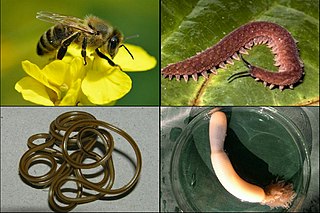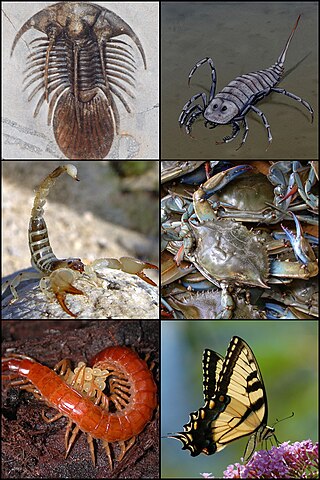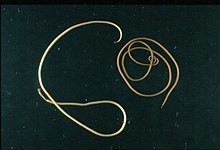
Ecdysozoa is a group of protostome animals, including Arthropoda, Nematoda, and several smaller phyla. The grouping of these animal phyla into a single clade was first proposed by Eernisse et al. (1992) based on a phylogenetic analysis of 141 morphological characters of ultrastructural and embryological phenotypes. This clade, that is, a group consisting of a common ancestor and all its descendants, was formally named by Aguinaldo et al. in 1997, based mainly on phylogenetic trees constructed using 18S ribosomal RNA genes.

Panarthropoda is a proposed animal clade containing the extant phyla Arthropoda, Tardigrada and Onychophora. Panarthropods also include extinct marine legged worms known as lobopodians ("Lobopodia"), a paraphyletic group where the last common ancestor and basal members (stem-group) of each extant panarthropod phylum are thought to have risen. However the term "Lobopodia" is sometimes expanded to include tardigrades and onychophorans as well.

Cycloneuralia is a clade of ecdysozoan animals including the Scalidophora, the Nematoida, and the extinct Palaeoscolecid. It may be paraphyletic, or may be a sister group to Panarthropoda. Or perhaps Panarthropoda is paraphyletic with respect to Cycloneuralia. The group has also been considered a single phylum, sometimes given the old name Nemathelminthes. The uniting character is the nervous system organization with a circumpharyngeal brain and somata–neuropil–somata pattern. The name derives from the position of the brain around the pharynx.
The oral polio vaccine (OPV) AIDS hypothesis is a now-discredited hypothesis that the AIDS pandemic originated from live polio vaccines prepared in chimpanzee tissue cultures, accidentally contaminated with simian immunodeficiency virus and then administered to up to one million Africans between 1957 and 1960 in experimental mass vaccination campaigns.

Tong Dizhou was a Chinese embryologist known for his contributions to the field of cloning. He was a vice president of Chinese Academy of Science.

Scalidophora is a group of marine pseudocoelomate protostomes that was proposed on morphological grounds to unite three phyla: the Kinorhyncha, the Priapulida and the Loricifera. The three phyla have four characters in common — chitinous cuticle that is moulted, rings of scalids on the introvert, flosculi, and two rings of introvert retracts. The introvert and abdomen are separated by a distinct neck region in all groups, but in adult macroscopic priapulids it becomes rudimentary in Priapulus and is completely absent in Halicryptus. However, the monophyly of the Scalidophora was not supported by two molecular studies, where the position of the Loricifera was uncertain or as sister to the Panarthropoda. Both studies supported a reduced Scalidophora comprising the Kinorhyncha and Priapulida as sister phyla. Their closest relatives are the Panarthropoda, Nematoda and Nematomorpha; thus, they are placed in the group Ecdysozoa.

Smith's dwarf chameleon, also known as the Elandsberg dwarf chameleon, is a species of lizard in the family Chamaeleonidae endemic to Fynbos in South Africa's Eastern Cape. As in several species of chameleons in the genus Bradypodion, the Smith's dwarf chameleon can use its color-changing ability to actively camouflage itself depending on the vision of the specific predator species by which it is being threatened.

Ephrin A3 is a protein that in humans is encoded by the EFNA3 gene.

EPH receptor A1 is a protein that in humans is encoded by the EPHA1 gene.

Phoronids are a small phylum of marine animals that filter-feed with a lophophore, and build upright tubes of chitin to support and protect their soft bodies. They live in most of the oceans and seas, including the Arctic Ocean but excluding the Antarctic Ocean, and between the intertidal zone and about 400 meters down. Most adult phoronids are 2 cm long and about 1.5 mm wide, although the largest are 50 cm long.

Protostomia is the clade of animals once thought to be characterized by the formation of the organism's mouth before its anus during embryonic development. This nature has since been discovered to be extremely variable among Protostomia's members, although the reverse is typically true of its sister clade, Deuterostomia. Well known examples of protostomes are arthropods, molluscs, annelids, flatworms and nematodes. They are also called schizocoelomates since schizocoely typically occurs in them.
Eurybacteria is a taxon created by Cavalier-Smith, which includes several groups of Gram-negative bacteria. In this model, it is the ancestor of gram positive bacteria. Their endospores are characterized by producing and presenting external flagella or mobility by bacterial displacement.

Planulozoa is a clade which includes the Placozoa, Cnidaria and the Bilateria. The designation Planulozoa may be considered a synonym to Parahoxozoa. Within Planulozoa, the Placozoa may be a sister of Cnidaria to the exclusion of Bilateria. The clade excludes basal animals such as the Ctenophora, and Porifera (sponges). Although this clade was sometimes used to specify a clade of Cnidaria and Bilateria to the exclusion of Placozoa, this is no longer favoured due to recent data indicating a sister group relationship between Cnidaria and Placozoa.
Eobacteria is a proposed clade characterized by Cavalier-Smith. Species in this group lack lipopolysaccharide.

The Articulata hypothesis is the grouping in a higher taxon of animals with segmented bodies, consisting of Annelida and Panarthropoda. This theory states that these groups are descended from a common segmented ancestor. The Articulata hypothesis is an alternative to the hypothesis that ecdysis is a primitive characteristic – this would place Panarthropoda in the group Ecdysozoa.

Nephrozoa is a proposed major clade of bilaterian animals. It includes all bilaterians other than Xenacoelomorpha. It contrasts with the Xenambulacraria hypothesis, which instead posits that Xenacoelomorpha is most closely related to Ambulacraria. Which hypothesis is correct is controversial. Authors supporting the Xenambulacraria hypothesis have suggested that the genetic evidence used to support Nephrozoa may be due to systematic error.
In molecular biology, mir-282 microRNA is a short RNA molecule. MicroRNAs function to regulate the expression levels of other genes by several mechanisms.
Direct development is a concept in biology. It refers to forms of growth to adulthood that do not involve metamorphosis. An animal undergoes direct development if the immature organism resembles a small adult rather than having a distinct larval form. A frog that hatches out of its egg as a small frog undergoes direct development. A frog that hatches out of its egg as a tadpole does not.













